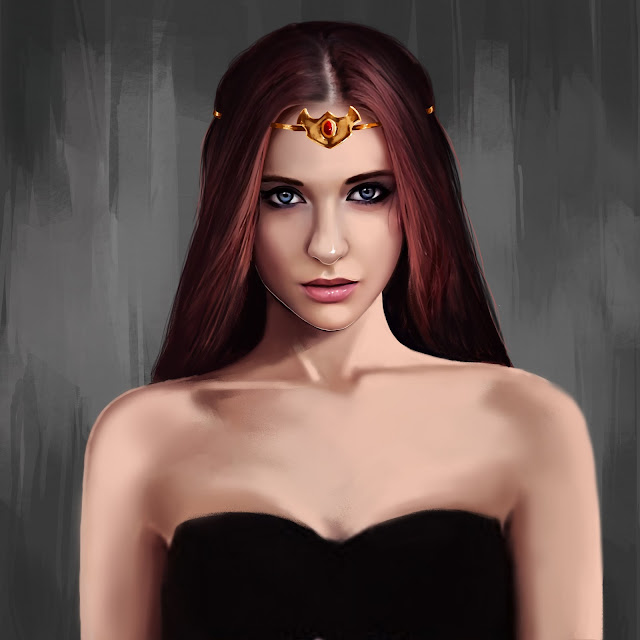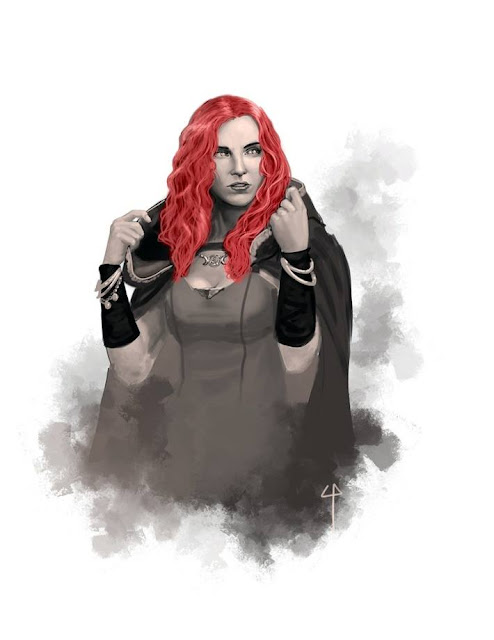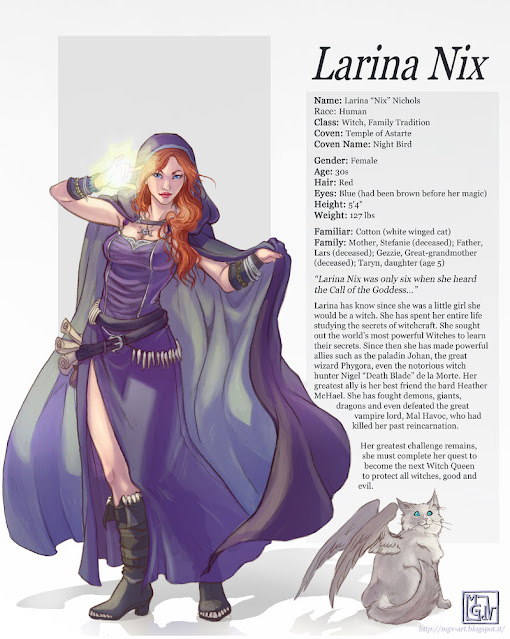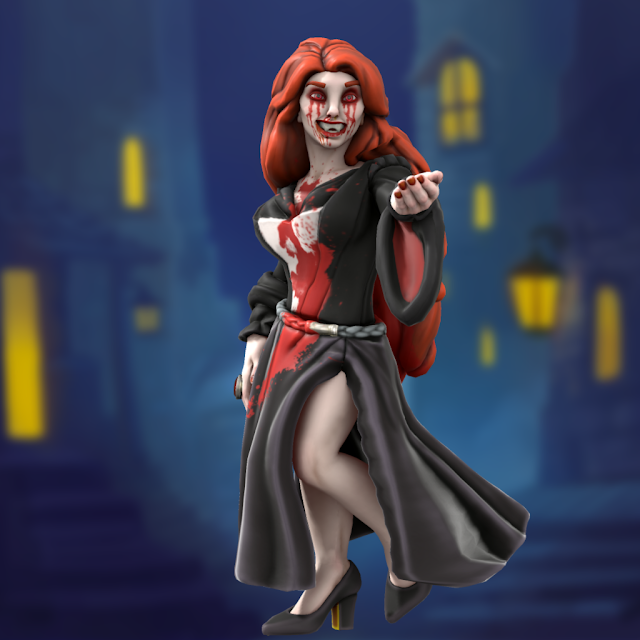Friday, May 6, 2011
Clerics in D&D
Here are some posts to illustrate what I mean,
http://www.wizards.com/dnd/article.aspx?x=dnd/4ll/20110426
http://www.wizards.com/DnD/Article.aspx?x=dnd/4ll/20110503#74170
http://lawfulindifferent.blogspot.com/2011/04/god-i-hate-clerics.html
http://daegames.blogspot.com/2011/04/who-wants-to-play-cleric_26.html
http://theresdungeonsdownunder.blogspot.com/2011/05/making-cleric-cleric-blank-religion.html
I am firmly in the camp of Clerics are as much a part of D&D as Fighters, Wizards and Thieves.
My first character ever was Father Johan Weper, Cleric of the God of the Sun, Hunter of the Undead. He was a bit of a generic cleric to be honest, and I choose the sun god because I thought that as a quasi-medieval priest the sun would be a major feature of all the is holy, bright and good. Plus I had been reading a bunch of Greek Myths and I though Apollo would make for a good god. But the real reason I choose the cleric; Turning Undead. That was an AWESOME power in my pre-teen mind. So that has colored my views of the cleric ever since.
In real life I am an atheist, but I like the play the religious character. So clerics, witches, druids, all fascinate me. But clerics are where it all started.
Clerics as Occult Researchers
In nearly every other game I have ever played there have been occult researchers. There is usually someone that is the pary's muscle, the magic-guy, the sneaky guy and then the smart guy. Sometime the magic guy and smart guy are the same, sometimes though they are not. The Cleric takes on the roll of the Smart Guy or the Occult Researcher. The books, the ill fitting glasses, and the wisdom to know what to do is the roll of the cleric.
It is fairly well known that the idea behind clerical undead turning came from Peter Cushing's Van Helsing characters in the various Hammer Dracula films. Why not extend the metaphor to include the rest of Van Helsing's portfolio. As a class that puts a high value on Wisdom then the cleric should be a font of knowledge. Sure, this can also be done by the Magic-User / Wiazard, but the cleric's input should not be understated.
In D&D 3 and 4 knowledge of the undead fall within the Knowledge (Religion) or just Religion category. These characters tend to have more training in this area than other characters. While wizards are typically the font of magical knowledge, clerics should be the source of knowledge beyond the ken of mortal man and into the realm of the gods.
Clerics as the Party Leader
The cleric also can serve the roll as the leader. While the cleric can run the gamut of influential high priest to crazy street prophet to diabolic cult leader, players typically take on the roll of the cleric of the local church, usually good. Certainly that is what D&D4 wants you to do and that is fine. This type of cleric also works as the default leader, whether he/she is or not. So if this is the hand you are dealt, then play it because clerics make great leaders. Under most circumstances they access to power, money, a hierarchy and can expect a modicum of respect from the locals. All this adds up to instant authority figure. Even if they are not.
Cleric as the Party Medic
The obvious role. Clerics have healing magic in earlier editions of the game, have spontaneous healing spells in the 3.x era and can activate healing surges in 4th. The role of the cleric cannot be overstated. Parties with out a cleric die.
During my run between 1st and 2nd Ed I created a Healer class. It shared a number of features that my Witch class did including the ability to heal by touch as she went up in level. Completely unneeded in 3.x of course, but in 2nd Ed it was quite a game changer. I also made an NPC healer a pacifist. She would never raise a weapon to any creature, unless of course it was undead and then she went all Peter Cushing on them. But running that class and character (she was the only character I ever made for that class) showed me how important the healing aspect was. There was not just the regaining hit points, there was the player morale. Also since the character was an NPC it was easy not to have her fight, but the Players really did everything they could to protect her.
BTW. Her name was Celene Weper and she was the youngest daughter of Father Werper above. Yes clerics in my world get married and have kids, since it is a life affirming thing.
Plus keep in mind that Clerics as Healers has a long tradition even in our own world. If ever a character decided to become a pure healing cleric and take an oath of non violence then I would give them XP for every hitpoint cured and a share of combat XP. I would also give them 2x the starting funds (even though they would give what they don't spend back to the church) to represent the investment their churches/hospitals have made in them. After all, can't send a healer out into the world with shoddy armor. Reflects bad on their organization.
Clerics as Combatants?
It almost seems counter to the above, but clerics are the second best major class when it comes to fighting. Only fighters (and their related classes) are better. The get good saves vs. magic due to their high wisdom, or Will saves for the same reason and their saves are pretty decent to start with. Plus they have one thing fighters don't have, the ability to use magic. So what you say, so can Wizards and even your favorite witch. Yes, but can they do it in field plate armor? Clerics can. Sure they do not get the combat spells the wizard gets, but they have a few good ones too. Creeping Doom is a nasty little spell for Druids. Finger of Death and reversed Heal spells can also ruin someone's day.
In games without Paladins, Clerics are the "righteous fist of (their) god". Wizards don't smite.
Clerics can also be one of the few character types that can actually kill monsters with out the moral hnagups. Even fighters, who get paid, and thieves, that might be working as assassins, don't get the same kind of "get out of jail free card" as do clerics operating within the doctrines of their faith and church. Think back to the Crusades and the Inquisition, the faithful got away with murder, torture and even more horrible crimes in the name of their God and the law had little to say about it or were in collusion with them.
Clerics might then be one of the more well rounded characters in the group.
Wednesday, August 4, 2021
#RPGaDAY2021 Day 4 Weapon
Excalibur, Stormbringer, Mjölnir, the Sun Sword, Blackrazor, Narsil/Andúril, the Bessy Mauler, the Sword of Kas, Needle, Elbe the Heartbow. All worlds, whether ours or fantasy have fantastic legendary weapons.
Quasi-artifacts to quest for or be granted to those that are worthy.
Day 4 Weapon
Like all good game worlds, I have a number of unique and special weapons.
Demonbane
Demonbane is a bastard sword from The Treasure Trove found in Issue #91 of Dragon Magazine. The sword is described as "a great, many-hued blade of which the origin has been forgotten, but which was wielded by the great paladin Nord in his single-handed destruction of the Citadel of Conjurers." Created by Ed Greenwood it would later go on to be called Dornavver in the Forgotten Realms. In my games, though it became one of the weapons of my paladin Johan II and used to defeat Orcus in module H4. IT was lost in the Astral Sea and it has been the focus of all my paladins for the last four generations to recover.
The "forgotten origin" has been changed to a drow savant, Sharis Val, that created it along with his adoptive father a dwarf cleric of Moradin. The multi-hues come from the variety of metals used in its construction.
Ebonblade, the Sword of Black Flames
Ebonblade's history is tied up in that of Demonbane's. The story of Demonbane's construction is not as forgotten as reported. Among blacksmiths, the tale of the swords construction and its use to defeat the Citadel of Conjurers is a tale told by masters to apprentices all over the world. One such apprentice found where the Demonbane was made and used the leftover materials to make a sword to avenge the death of his killed master. The materials used in making Demonbane responded to Sharis Val's desire to rid the world of evil and in particular demons. Ebonblade responded to the hate and desire to kill others and thus became an evil weapon.
The Star Sword
This weapon was made from bit of a "star" the fell to the Earth. Longer than a bastard sword, but not quite as long as a two-handed sword. This sword focuses the magic energies of the wielder into the blade to add extra damage.
The Mace of St. Werper
Admittedly not all that different than the Mace of St. Cuthbert, in my defense I made mine before I ever read about it in the DMG. This one though was specific to my first cleric.
The Death Staff
This weapon is the very first Staff of the Warlock used by my character Magnus. It can blast a humanoid with its necrotic power and turn them into a zombie under the wielder's control.
What weapons populate your world?
Thursday, August 25, 2022
#RPGaDAY2022 Day 25 - Where has the character been?
I suppose for the purposes of this #RPGaDay I should have started out with just one character. But where is the fun in that?
So the Werper family began in Mystara, Glantri to be exact. I know clerics in Glantri. But when I moved over to AD&D 1st Ed my DM and I merged our worlds (me Mystara, him Oerth) Glantri changed a bit. Since then Johan the III was trapped in Ravenloft and thought to be lost. Johan the IV was the first ever to travel to the Forgotten Realms. All of them have been to Abyss to fight demons, their sworn enemies and Johan II even ended up in London in the 1980s.
Likewise, Larina has been EVERYWHERE.
But I love a good plane-hopping adventure.
War of the Witch Queens will introduce my kids to my favorite playground, the Multi-verse. They have already been Krynn, but didn't know it yet.
Tuesday, August 8, 2023
#RPGaDay2023 Favourite CHARACTER
I do have a few. There is the whole Werper family with Johan I as the first character I ever created and played for longer than one session. Every version of *D&D gets a new version of Johan as either a Paladin or Cleric. A (mostly) unbroken line of father and son dedicated to fighting evil, particularly the undead.
But I have to say my favorite character has to be my little witch Larina Nix/Larina Nichols. Johan gets a new version (a son of the previous) in every version of D&D. Larina gets a version for every game I ever play. I don't play her in every game, but I at least give her a try in the character creation rules.
I also like to get custom art of her and support artists.
I might be a little obsessed.
Wednesday, March 6, 2019
Darlessa the Vampire Queen
One of the first adventures I worked on for OSR publication was called "The Tomb of the Vampire Princess" or "Vampire Queen" or "Palace" depending on my mood at the time.
I essentially saw it as a sequel of sorts to the original Wee Warriors / Pacesetter Games "Palace of the Vampire Queen". But a few things happened. First Mark Taormino published his own "Hanging Coffins of the Vampire Queen" which was AWESOME. Then Bill Barsh of Pacesetter Games produced some sequels of his own with Castle Blood and Crypts of the Living.
So the need for my own sequel dwindled.
A couple years back Small Niche Games produced Guidebook to the Duchy of Valnwall. I had the pleasure of working on that product. I submitted a character to be "Saint" in the game, Father Johan Werper, my very first D&D character ever. When I got my copy I was so thrilled. Something I had wanted to happen for ages was going to happen, Johan was going to be a real saint in a "D&D" book! I opened it up and I was not disappointed at all! Moreover the book's main author and designer Pete Spahn had added this section:
He died in a tragic tale that is recounted in the Hunt for the Dark Mistress, where he tracked down and slew Darlessa the Vampire Queen who had abducted his granddaughter.Pete never contacted me about this and I could not have been happier! Without knowing it he included things that happened in my game; Johan dying and leaving his granddaughter, Celene, behind (Celene was my first 2nd Ed character, and afraid of the dark. Now I know why). The use of holy oil in my games (does 1d8 damage to undead; more when lit) and of course giving a name to an enemy that had been lurking in the back of my mind ever since I first read about Elizabeth Bathory.
Unfortunately, Johan was himself cursed by the taint of the vampire's blood. Rather than remain an undead abomination, he bid goodbye to his granddaughter and used the last of his strength to douse his body with oil and set himself alight.
It was like throwing a deck of cards into the air and having them land in a perfect house of cards.
So modules V5 and V6 combined will cover a lot of similar territory to what I was going to do in my adventure. So I'll just drop that and keep the elements that are new. The opening of the crypts.
I have a stack of various notes, maps, ideas and going through them all I think I have something pretty cool here. I'll have to get it all together in time for my annual Halloween horror game.
Right now the working title is Descent into the Crypts of the Vampire Queen. It will be my homage to the great adventures of the Golden Era but also a nod to the two Vampire Queen adventures that brought me so much joy.
Here she is for Advanced Labyrinth Lord.
Darlessa, The Queen of Vampires
Female Vampire Witch, Demonic Tradition
No. Enc.: 1 (Unique)
Alignment: Chaotic (evil)
Movement: 120’ (40’)
Fly: 180’ (60’)
Armor Class: -5 (bracers of defense, amulet of protection, ring of protection)
Hit Dice: 13
Attacks: 1 (touch, see below) or spell
Damage: 1d10, drain 2 points of Constitution, witch Spells
Save: W13
Morale: 12
Hoard Class: XXII
XP: 11,400
Str: 18 Int: 15 Wis: 14 Dex: 18 Con: (18) Cha: 22
In addition to the powers of a vampire, Darlessa has the following witch spells and Occult Powers. She casts as a 13th level witch.
Spells by Level
Cantrip (3+5): Alarm Ward, Black Flame, Daze, Knot, Mend, Mote of Light, Object Reading, Spark
1st (4+3): Burning Hands, Cause Fear, Everlasting Candle, Hecate's Spiritual Dog, Minor Curse, Read Languages
2nd (4+3): Agony, Bewitch II, Burning Gaze, Enthrall, Ghost Touch, Produce Flame, Rite of Remote Seeing
3rd (3+2): Astral Sense, Clairaudience/Clairvoyance, Danse Macabre, Toad Mind, Tongues
4th (3+2): Arcane Eye, Bewitch IV, Elemental Armor, Moonlit Way, Phantom Lacerations
5th (2): Death Curse, Greater Command
6th (2): Death Blade
7th (1): Wave of Mutilation
Occult Powers
Familiar (Undead Raven)
Evil’s Touch
Devil’s Tongue
Magic Items
Intangible Cloak of Shadows, Amulet of Protection* (also prevents cleric turning), bracers of defense, ring of protection, ring spell storing.
Links to Adventures
- V2 Palace of the Vampire Queen reprint from Pacesetter Games
- V5 Palace of the Vampire Queen: Castle Blood (Pacesetter Games)
- V6 Palace of the Vampire Queen: Crypts of the Living (Pacesetter Games)
- MM1 Hanging Coffins of the Vampire Queen (Maximum Mayhem Dungeons / Dark Wizard)
- COA04SE: Guidebook to the Duchy of Valnwall Special Edition (SNG)
- Palace of the Vampire Queen
- Getting Basic
- All Hail the Vampire Queen!
- Into the Lair of the Vampire Queen
- A to Z of Vampires: Vampire Queen
- Weekend Gaming: Halloween Gaming, Return of the Vampire Queen

















